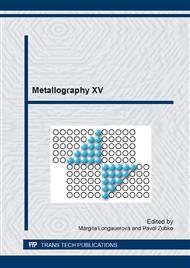[1]
D.S. Yang, A.H. Zewail, Ordered water structure at hydrophobic graphite interfaces observed by 4D, ultrafast electron crystallography, Proc. Natl. Acad. Sci. 106 (2009) 4122–4126.
DOI: 10.1073/pnas.0812409106
Google Scholar
[2]
W. Essafi, A. Abdelli, G. Bouajila, and F. Boué, Behavior of hydrophobic polyelectrolyte solution in mixed aqueous/organic solvents revealed by neutron scattering and viscosimetry J. Phys. Chem. B 116 (2012) 13525−13537.
DOI: 10.1021/jp3085815
Google Scholar
[3]
A. Papagiannopoulos, C.M. Fernyhough, T.A. Waigh, and A. Radulescu, Scattering study of the structure of polystyrene sulfonate comb polyelectrolytes in solution, Macromol. Chem. Phys. 209, (2008), 2475–2486.
DOI: 10.1002/macp.200800428
Google Scholar
[4]
H. Coelfen, M. Antonietti, Mesocrystals: Inorganic superstructures made by highly parallel crystallization and controlled alignment, Angew. Chem. 44 (2005) 5576-5591.
DOI: 10.1002/anie.200500496
Google Scholar
[5]
T. Dobbins, R. Chevious and Y. Lvov, Behavior of Na+-polystyrene sulfonate at the interface with single-walled carbon nanotubes (SWNTs) and its implication to SWNT suspension stability, Polymers 3 (2011) 942-954.
DOI: 10.3390/polym3020942
Google Scholar
[6]
A. Gromer, M. Rawiso, M. Maaloum, Visualization of Hydrophobic Polyelectrolytes Using Atomic Force Microscopy in Solution, Langmuir Vol. 24 No. 16 (2008).
DOI: 10.1021/la8009139
Google Scholar
[7]
J. P. Guthrie, Hydrolysis of esters of oxy acids: pKa values for strong acids. Can. J. Chem. 56 (1978) 2342-2354.
Google Scholar
[8]
M. Muthukumar, Theory of Counter-Ion Condensation on Flexible Polyelectrolytes: Adsorption Mechanism. J. Chem. Phys. 120 (2004) 9343-9350.
DOI: 10.1063/1.1701839
Google Scholar
[9]
V. K. Paruchuri, A. V. Nguyen, J. D. Miller, Zeta-potentials of self-assembled surface micelles of ionic surfactants adsorbed at hydrophobic graphite surfaces, Colloids and Surfaces A 250 (2004) 519–526.
DOI: 10.1016/j.colsurfa.2004.04.098
Google Scholar
[10]
Y. Singh, R. J. Deshpande, S. Subramanian Proceedings of the International Seminar on Mineral Processing Technology – (2006), Chennai, India pp.292-296.
Google Scholar


